The world of cryptocurrency is no stranger to volatility, but the stability of stablecoins is often considered a bedrock in the digital asset ecosystem. Recently, a report surfaced questioning whether Binance’s pegged BUSD stablecoin was consistently fully backed. This sparked a wave of discussion and raised eyebrows across the crypto community. Let’s dive into what happened and what it means for the future of stablecoins.
The Allegations: Was Binance-Peg BUSD Undercollateralized?
A Bloomberg report suggested that Binance-Peg BUSD, a version of the BUSD stablecoin pegged to its value, might not have always been fully backed by the actual BUSD. This claim was based on an analysis by Jonathan Reiter, co-founder of ChainArgo, who pointed to data indicating potential undercollateralization between 2020 and 2021. At times, the gap reportedly exceeded a staggering $1 billion. This raises a crucial question: what’s the difference between BUSD and Binance-Peg BUSD?
Understanding the Difference: BUSD vs. Binance-Peg BUSD
It’s important to distinguish between these two entities:
- Binance USD (BUSD): This is the original BUSD stablecoin issued by Paxos and regulated by the New York Department of Financial Services (NYDFS). Binance has a licensing agreement with Paxos to use the BUSD name.
- Binance-Peg BUSD: This is a Binance-issued stablecoin that aims to mirror the value of BUSD. It operates on blockchains where native BUSD isn’t available.
Think of it like this: BUSD is the original, fully-backed dollar bill, while Binance-Peg BUSD is like a voucher that should always be redeemable for that dollar bill. The concern was whether Binance consistently held enough BUSD to cover all the outstanding Binance-Peg BUSD.
Binance’s Response: A Matter of Timing?
Initially, Binance pushed back against the report. They explained the discrepancy as a “timing mismatch in backing Binance-Peg BUSD with BUSD.” Essentially, they argued that while there might have been brief periods where the on-chain data didn’t perfectly align, the backing was always there. They later clarified the distinction between a pegged and a backed stablecoin, emphasizing that Binance-Peg BUSD is backed by BUSD, which itself is fully backed.
Binance stated in a blog post:
“Despite data variances, user redemptions were never impacted.”
This is a key point. Even if there were temporary discrepancies in the data, Binance claims that users were always able to redeem their Binance-Peg BUSD. They also highlighted that the Paxos-issued BUSD remains unaffected, as it’s regulated and audited monthly.
Echoes of the Past: Lessons from Terra and Tether
This situation brings back memories of other stablecoin controversies. The collapse of TerraUSD (now TerraClassicUSD) in 2022 sent shockwaves through the crypto market, highlighting the potential risks associated with algorithmic stablecoins. This event, along with the failures of other major crypto platforms like Voyager Digital and FTX, has intensified scrutiny on the entire digital asset space.
Tether (USDT), another dominant stablecoin, has also faced similar allegations regarding its backing. In 2019, questions arose about whether USDT was truly backed 1:1 with USD. A U.S. judge eventually ordered Tether to provide proof of its reserves. Furthermore, in 2021, Bitfinex and Tether agreed to pay $18.5 million to the New York Attorney General for misrepresenting the extent of USDT’s backing.
What Does This Mean for Crypto Users?
The Binance-Peg BUSD situation, along with past stablecoin controversies, underscores the importance of transparency and trust in the crypto ecosystem. Here are some key takeaways:
- Understand the Different Types of Stablecoins: Not all stablecoins are created equal. Some are backed by fiat currency, others by other cryptocurrencies, and some are algorithmic. Each type carries different risks.
- Do Your Research: Before investing in any stablecoin, understand its backing mechanism, regulatory oversight, and audit history.
- Diversification is Key: Don’t put all your eggs in one basket. Spreading your investments across different stablecoins (and other asset classes) can help mitigate risk.
- Stay Informed: Keep up-to-date with news and developments in the crypto space, particularly regarding the stablecoins you hold.
Looking Ahead: Increased Scrutiny on Stablecoins
The scrutiny surrounding Binance-Peg BUSD reflects a broader trend of increased regulatory attention on stablecoins. Following the tumultuous events of 2022, regulators worldwide are focusing on ensuring the stability and transparency of these digital assets. This increased oversight could lead to stricter regulations and greater accountability for stablecoin issuers.
Conclusion: Navigating the Stablecoin Landscape
The debate around Binance-Peg BUSD’s backing highlights the ongoing evolution of the cryptocurrency market. While Binance maintains that any discrepancies were due to timing issues and did not impact users, the incident serves as a reminder of the critical importance of transparency and proper backing for stablecoins. As the regulatory landscape evolves, understanding the nuances of different stablecoins and staying informed will be crucial for navigating the digital asset space responsibly. The future of stablecoins will likely involve greater scrutiny and a continued push for transparency, ultimately aiming to build a more robust and trustworthy ecosystem for all participants.
Disclaimer: The information provided is not trading advice, Bitcoinworld.co.in holds no liability for any investments made based on the information provided on this page. We strongly recommend independent research and/or consultation with a qualified professional before making any investment decisions.


